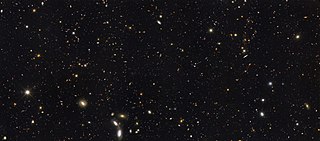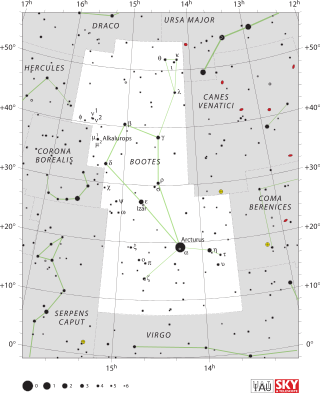Related Research Articles
The following is a timeline of galaxies, clusters of galaxies, and large-scale structure of the universe.

A barred spiral galaxy is a spiral galaxy with a central bar-shaped structure composed of stars. Bars are found in about two thirds of all spiral galaxies in the local universe, and generally affect both the motions of stars and interstellar gas within spiral galaxies and can affect spiral arms as well. The Milky Way Galaxy, where the Solar System is located, is classified as a barred spiral galaxy.
Luminous infrared galaxies or LIRGs are galaxies with luminosities, the measurement of brightness, above 1011 L☉. They are also referred to as submillimeter galaxies (SMGs) through their normal method of detection. LIRGs are more abundant than starburst galaxies, Seyfert galaxies and quasi-stellar objects at comparable luminosity. Infrared galaxies emit more energy in the infrared than at all other wavelengths combined. A LIRG's luminosity is 100 billion times that of the Sun.

APM 08279+5255 is a very distant, broad absorption line quasar located in the constellation Lynx. It is magnified and split into multiple images by the gravitational lensing effect of a foreground galaxy through which its light passes. It appears to be a giant elliptical galaxy with a supermassive black hole and associated accretion disk. It possesses large regions of hot dust and molecular gas, as well as regions with starburst activity.

The Extended Groth Strip is an image of a small region between the constellations of Ursa Major and Boötes, based on the results of a series of observations by the Hubble Space Telescope. It covers an area 70 arcminutes across and 10 arcminutes wide, which correlates to a patch of sky roughly the width of a finger stretched at arm's length. The image was assembled from over 500 separate exposures taken with the Space Telescope's Advanced Camera for Surveys at 63 different pointings, spread out over the course of one year from June 2004 to March 2005. The complete image at the highest resolution in JPEG format is nearly 250 megabytes.

The Great Observatories Origins Deep Survey, or GOODS, is an astronomical survey combining deep observations from three of NASA's Great Observatories: the Hubble Space Telescope, the Spitzer Space Telescope, and the Chandra X-ray Observatory, along with data from other space-based telescopes, such as XMM Newton, and some of the world's most powerful ground-based telescopes.
Tim Richard Walter Schrabback–Krahe is KIPAC Fellow at the Kavli Institute of Particle Astrophysics and Cosmology, which is based at Stanford University. He is working within the X-ray Astronomy and Observational Cosmology Group. His research focuses on weak gravitational lensing and its applications for cosmology and astrophysics.
MACS0647-JD is a galaxy with a redshift of about z = 10.7, equivalent to a light travel distance of 13.26 billion light-years. If the distance estimate is correct, it formed about 427 million years after the Big Bang.

Simon John Lilly FRS is a professor in the Department of Physics at ETH Zürich.

GN-z11 is a high-redshift galaxy found in the constellation Ursa Major. It is among the farthest known galaxies from Earth ever discovered. The 2015 discovery was published in a 2016 paper headed by Pascal Oesch and Gabriel Brammer. Up until the discovery of JADES-GS-z13-0 in 2022 by the James Webb Space Telescope, GN-z11 was the oldest and most distant known galaxy yet identified in the observable universe, having a spectroscopic redshift of z = 10.957, which corresponds to a proper distance of approximately 32 billion light-years. Data published in 2024 established that the galaxy contains the most distant, and therefore earliest, black hole known in the universe, estimated at around 1.6 million solar masses.
Sangeeta Malhotra is an astrophysicist who studies galaxies, their contents, and their effects on the universe around them. The objects she studies range from our own Milky Way galaxy to some of the earliest and most distant known galaxies in the epoch of cosmic dawn.

Webb's First Deep Field is the first operational image taken by the James Webb Space Telescope (JWST). The deep-field photograph, which covers a tiny area of sky visible from the Southern Hemisphere, is centered on SMACS 0723, a galaxy cluster in the constellation of Volans. Thousands of galaxies are visible in the image, some as old as 13 billion years. It is the highest-resolution image of the early universe ever taken. Captured by the telescope's Near-Infrared Camera (NIRCam), the image was revealed to the public by NASA on 11 July 2022.

CEERS-93316 is a high-redshift galaxy with a spectroscopic redshift z=4.9. Significantly, the redshift that was initially reported was photometric and would have made CEERS-93316 the earliest and most distant known galaxy observed.
Viviana Acquaviva is an Italian astrophysicist who is a professor in the Department of Physics at the New York City College of Technology. Her research interests consider data science and machine learning for physics and astronomy. She was named one of Italy's most inspirational technologists in 2019.
Caitlin M Casey is an observational astronomer and associate professor at the University of Texas at Austin. She is known for her work in extragalactic astrophysics where she works on the formation and evolution of galaxies.
F200DB-045 is a candidate high-redshift galaxy, with an estimated redshift of approximately z = 20.4, corresponding to 168 million years after the Big Bang. If confirmed, it would be one of the earliest and most distant known galaxies observed.

Maisie's Galaxy is a distant galaxy located at z=11.4 that existed 390 million years after the beginning of the universe.
CEERS-2112 is the most distant barred spiral galaxy observed as of 2023. The light observed from the galaxy was emitted when the universe was only 2.1 billion years old. It was determined to be similar in mass to the Milky Way.

The COSMOS field, or the Cosmic Evolution Survey Deep Field, is a stitched photograph of deep space, which was photographed with the Hubble Space Telescope's Advanced Camera for Surveys in segments from 2003 to 2005, and was supported by several other ground-based and space-based telescopes. It was the capstone of the COSMOS project, which aimed to observe and study how galaxies are affected by celestial environments.
References
- ↑ Meg (2016-01-18). "Introducing Jeyhan Kartaltepe". astrotweeps. Retrieved 2023-03-29.
- ↑ Kartaltepe, Jeyhan Sevim (2009). "A multiwavelength study of (ultra)luminous infrared galaxies in the cosmos field".
- ↑ "Jeyhan Kartaltepe". www.sissa.it. Retrieved 2023-03-29.
- ↑ "People | LAMA | RIT". www.rit.edu. Retrieved 2023-03-29.
- ↑ "Team Members". ceers.github.io. Retrieved 2023-03-29.
- ↑ "Center for Computational Relativity and Gravitation (CCRG)". ccrg.rit.edu. Retrieved 2023-03-29.
- ↑ "James Webb Space Telescope study reveals wide diversity of galaxies in the early universe". EurekAlert!. Retrieved 2023-03-29.
- 1 2 3 Jenner, Lynn (2021-08-17). "Mapping the Universe's Earliest Structures with COSMOS-Webb". NASA. Retrieved 2023-03-29.
- ↑ Webb, Stephen (2012), "A new messenger from the cosmos", New Eyes on the Universe, New York, NY: Springer New York, pp. 203–226, doi:10.1007/978-1-4614-2194-8_9, ISBN 978-1-4614-2193-1 , retrieved 2023-03-29
- ↑ "Home Page". COSMOS. Retrieved 2023-03-29.
- 1 2 "How the James Webb Space Telescope has revealed a surprisingly bright, complex and element-filled early universe | Technology". Devdiscourse. Retrieved 2023-03-29.
- ↑ O'Callaghan, Jonathan. "The James Webb Space Telescope's First Year of Extraordinary Science Has Been Revealed". Scientific American. Retrieved 2023-03-29.
- ↑ "Our universe mastered the art of making galaxies while it was still young". Popular Science. 2023-01-16. Retrieved 2023-03-29.